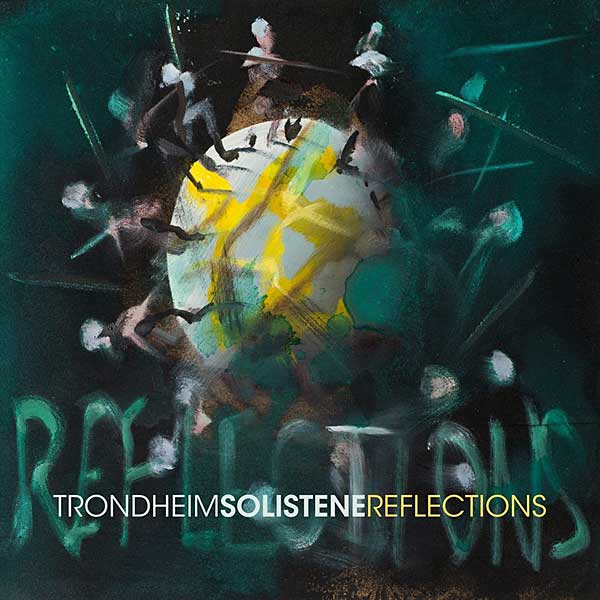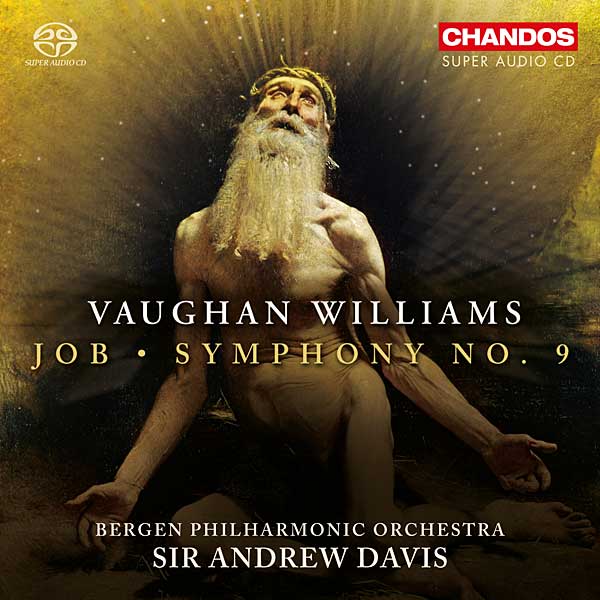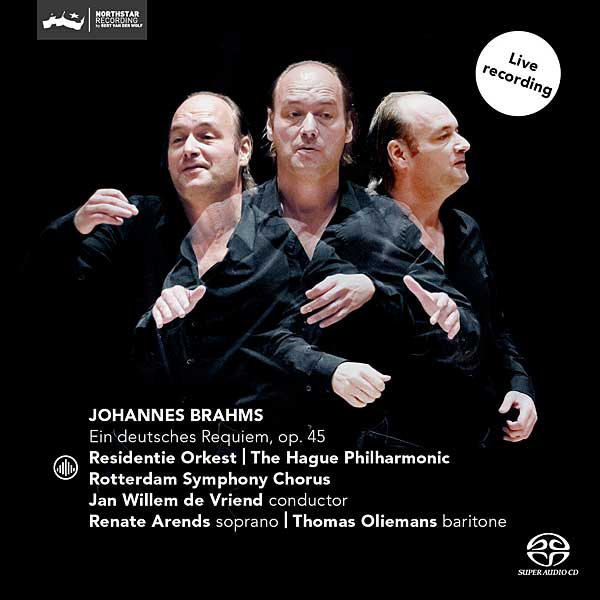| Columns Retired Columns & Blogs |
Niche: Audiophilia
Micro-niche: MQA
Nano-niche: Multichannel MQA
TRONDHEIM SOLOISTS: Reflections
Britten: Variations on a Theme of Frank Bridge. Stravinsky: Apollon Musagète. Vaughan Williams: Fantasia on a Theme by Thomas Tallis.
Trondheim Soloists; Øyvind Gimse, artistic dir.; Geir Inge Lotsberg, guest leader
2L 2L-125-SABD (SACD/CD+BD). 2016. Morten Lindberg, prod., eng. DDD. TT: 70:16
This recording was nominated for a Grammy for Best Surround Recording. The winner is more than fine (you can look it up), but we wuz robbed! Perhaps the Trondheim Soloists' 2L recordings are now quantities too well known—but as wonderful as was the Grammy winner, from Seattle, if you miss Reflections, you'll miss 2L's best—and, perhaps, the best chamber-orchestra recording ever.

I've been enjoying it from the day it arrived, and the Trondheimers never fail to impress me with the unanimity of their stylish playing. Britten's Variations on a Theme of Frank Bridge are delightfully brilliant, Vaughan Williams's familiar Tallis Fantasia is serene, and the Stravinsky is elegant. However, 2L has outdone itself in this release by introducing a tiny increment of warmth and weight, to achieve a perfect tonal balance. Add to that their practice of subtly immersing the listener in the ensemble, and the result is a thrilling listening experience.
VAUGHAN WILLIAMS: Job, Symphony 9
Martin Winter, flugelhorn; Alexander Kagan, violin; Sigurd Malvër Ogaard, organ; Bergen Philharmonic Orchestra, Sir Andrew Davis
Chandos CHSA 5180 (SACD). 2017. TT: 72:02.
I always think of these two works by Vaughan Williams (1872–1958) together. I was introduced to them in performances conducted by Sir Adrian Boult in recording sessions attended by the composer in the final months of his life, and released on stereo Everest LPs engineered by Joe Kane. Boult was Vaughan Williams's major exponent, and those recordings seemed to possess an explicit sense of mission and engagement. Davis and the Bergen Philharmonic come close to that in their commitment to the music, but also enjoy the advantages of modern multichannel recording.
Despite the 30 years that separate the composition of these works, I hear the same musical language stoked with passion, and speaking in many colors. In 1958, Job was a revelation to me. With liberal use of percussion, each of the scenic descriptions is expressed with distinct flavor and drama. Symphony 9, too, displays wide-ranging orchestration and an exciting interplay of meters.

The BPO plays beautifully, especially the winds and the flugelhorn soloist. Davis's pacing is a bit less flexible than Boult's, but it's convincing, particularly in the more dramatic sections of both works. The perspective on the orchestra is relatively close-up, with great detail and a sense of scale. The bass was a bit light at first hearing, but the overall impression is effective and convincing.
SIBELIUS: Kullervo, Finlandia
KORTEKANGAS: Migrations
Lilli Paasikivi, mezzo-soprano; Tommi Hakala, baritone; YL Male Voice Choir; Minnesota Orchestra, Osmo Vänskä
BIS BIS-9048 (2 SACD/CDs). 2017. Robert Suff, prod.; Marion Schwebel, eng. DDD. TT: 117:00.
In my May 2007 column, I talked about three new SACD recordings of Kullervo, Sibelius's early bardic masterpiece. Colin Davis with the London Symphony (LSO Live LSO0574) was bland, and Ari Rasilainen with the Rheinland-Pfalz State Philharmonic (CPO 777 196-2) had an outstanding chorus and was stylish, but with distant sound and an only capable orchestra. Therefore, Goldilocks chose as the clear multichannel winner Robert Spano and the Atlanta Symphony (Telarc SACD-60665). Still, none of these three could replace the best stereo versions.

Now comes a Kullervo that has everything: careful attention to the work's subtly shifting rhythms, control and restraint in the long declamatory passages, and careful inflexion of dramatic power. There is certainly no question of the Minnesota Orchestra's virtuosity, and the YL Male Voice Choir offers another performance as strong and impressive as the one in the Rasilainen recording. The vocal soloists, too, are excellent, but what makes this disc exceptional is Vanska's talent in reducing the episodic nature of the transitions through the hero's life events to produce an integrated narrative. BIS's sound is clean, detailed, and powerful. Like Kullervo, the Migrations of Olli Kortekangas (b. 1955) is somewhat exhortatory, but makes for a modern program pairing. I've been waiting for this one, and it's all that I expected.
BRAHMS: Ein deutsches Requiem
Renate Arends, mezzo-soprano; Thomas Oliemans, bass; The Hague Philharmonic, Rotterdam Symphony Chorus; Jan Willem de Vriend
Challenge Classics/North Star Recordings (SACD/CD). 2016. Bert van der Wolf, eng. TT: 61:22.
Of the many recordings of this work, most people will have their favorites. Mine include the 1955 recording with Fischer-Dieskau and GrÅmmer, and Rudolf Kempe conducting the St. Hedwig's Choir and the Berlin Philharmonic (2 LPs, Electrola/German EMI SMVP 8046/47); and the 1961 version with Fischer-Dieskau, Schwarzkopf, and Otto Klemperer leading the Philharmonia Orchestra and Chorus (EMI 5 66955 2). Both are rather monumental performances of deep feeling and respect.

Jan Willem de Vriend matches those qualities, but his more tender and reverential approach offers a satisfying alternative. What really sets it apart is that it was recorded in concert, and conveys a sense of the performers' communication with the audience, aided in no small way by a most remarkable recording. The warm acoustic of the Zuiderstrandtheater bathes performers and listener alike, and the relatively distant perspective remains restrainedly intimate. Despite that, the amount and clarity of instrumental detail are retained: especially in the low brass and strings, I could relish the scoring as in no other recording of this work that I have heard. The Hague and Rotterdam forces are excellent, save for a less-than-sublime patina in the violins—and while Thomas Oliemans is outstanding, Dietrich F-D he ain't.—Kalman Rubinson

Niche: Audiophilia
Micro-niche: MQA
Nano-niche: Multichannel MQA

Granted but it's in such obscure niches where one finds the gems. ;-)

I wasn't sure i understood the problem with room correction DSP and MQA. If the dac converts prior to sending to a processor or sends the unfolded MQA stream digitally to a processor, and suppose the processor is the unit applying room correction, what would be the issue?

But after the DAC, you have analog. So, in order to do any DSP, you would have to redigitize the signals. As a result, yes, you would have MQA but it is probable that any advantage that may be would be negated by any additional analog-to-digital-to-DSP-to-digital machinations.

All the USB DAC's were synchronized by WCLK in a daisy chain. How did you checked out, that there is no delay between L/R + C/LFE + SL/SR?

I didn't but I imagine that it is the reason for synchronizing the WCLK. If you suspect that there is a problem with this procedure (I have no reason to believe there is), ask Mytek.
FWIW, I erred, once or twice, in setting the CLK for one of the DACs to "Internal" and the sound was not good.

There is no doubt about the WLCK interconnection, that the DAC are in sync. Normal consumer OS are not able to give out a proper sync.
The question was about a constant shift between the stereo DAC.
E. g. the L/R could be earlier like the C/LFE and SL/SR are somewhere. You won't recognice it so easily, because there will be no extra distortion. Just the soundfield will be somehow different.
Was there any procedure to do?

Understand that point but there is no procedure involved as far as I know. The L/R DAC generates the CLK which is sent to the C/Sub DAC and then relayed to the SL/SR DAC. I doubt that this is a problem considering that the links were very short and any timing differences would be inordinately less than those caused by speaker placement errors on the sub-millimeter level.
Again, if you are concerned about this, ask Mytek as I am not bothered by it.

I really appreciated this column on MQA; I plan now to closely follow its commercial development.
I noticed in Manufacturers' Comments in the hard copy of Stereophile in which your column originally appeared that MQA's Bob Stuart observed that it is technically possible to perform EQ and other DSP in MQA, so I'm hoping that when multichannel MQA enabled units are ultimately sold to the public it will integrate DSP.
Multichannel DSD has the same problem. I am particularly concerned with speaker distance adjustments and bass management being only as good as the "fidelity" of the DSD to PCM conversion mechanics. Have you found a way to handle DSP purely in DSD?

I have not found an effective way to do DSP in DSD but I have also not found any significant disadvantage to DSD-to-PCM conversions.

I understand the necessity of DSD to PCM conversion when playing a multichannel SACD. But given the large file sizes, isn't more practical to stick to high resolution PCM multichannel downloads in FLAC, given that it is highly likely that the master was in DSD and the PCM conversion has already been made in the mixing process?
P.S. I really enjoy your Stereophile column; it is the first thing I look for when I open my copy of the magazine.

I am not concerned with the file size and I do not see a consistent advantage for PCM or DSD given the wide range of available resolutions.
Generally, I download in the format and resolution in which the recording was made, if that information is available.
Thanks for your comments.

I have trouble understanding what the resistance to multi-channel is. Its superiority seems so obvious to me--truly glorious when well-implemented! A real advance in recorded music, IMO.
Thank you for your efforts--it seems like MC might disappear without it. I buy many of your recommended recordings, too. The 2L recordings are incredible!

I acquired a copy of Reflections based on your review, and I received it yesterday. I noticed that there are a number of versions of the album in different formats, with different resolutions. It looks like the one to focus on is the 5.1 DTS-HD 24/384 copy, but I also wanted to mention that there is a lower resolution copy mastered (encoded? not certain of the appropriate verb here) in ATMOS, which should be fun to compare.
I also found to my delight that you can extract MQA encoded FLAC files, so I now have a great collection of 24/384 MQA titles to listen to on my MQA capable media player.
Interestingly, these are all on a Blu-Ray Audio disc, but they also include a copy on SACD. May I assume that the SACD version will be inferior to the 5.1 DTS-HD version or would I be in error in thinking that?
I'm very much looking forward to listening to this over the weekend. And it all of a sudden occurs to my why I might want full range speaker for my surround channels, since with this recording there is no "front" orientation, you are truly in the center of the action from what I understand.
Thanks for the recommendation. While I tracked down the winner of the Grammy for Surround recording, I also spotted that Dire Straits "Love Over Gold" is also available, one of my very favorite albums, so one of this is UPS'ing it's way to me at this very moment. Have you heard it? What did/do you think of it?
***UPDATE***
I listened to Reflections several times this weekend, what a wonderful recording! I settled on listening to the 5.1 DTS-HD version for a full listening, but experimented with the Atmos copy too. Overall, I think the Atmos copy did a slightly better job of the surround placement of instruments, but the lower resolution (96k) was a bit of a drawback when compared to the 384k DTS-HD version. I listened to the stereo MQA tracks on my Pioneer PMP and that sounded just outstanding, even on my lesser bedroom system.
There is also a SACD copy - I wonder, are there any advantages that this version may have that the ones on the Blu-Ray do not?

I need a little advice. what are the best usb cables and hub for HIFI to connect a BlueSound vault to a PC and a DROBO? Any help is much appreciated.